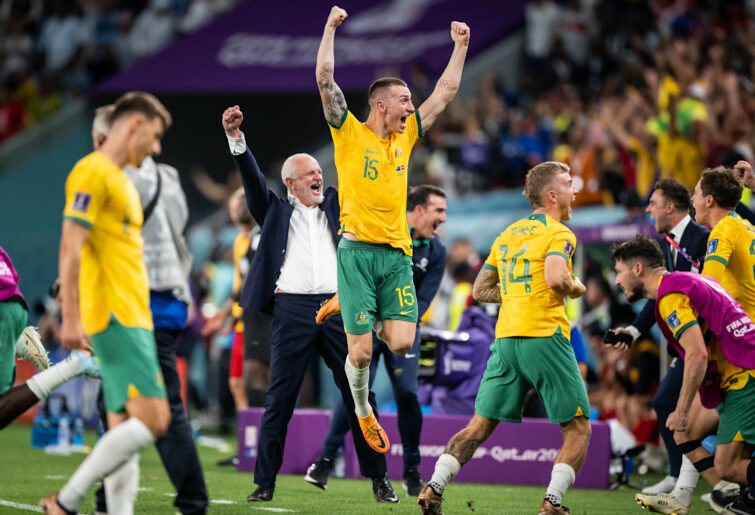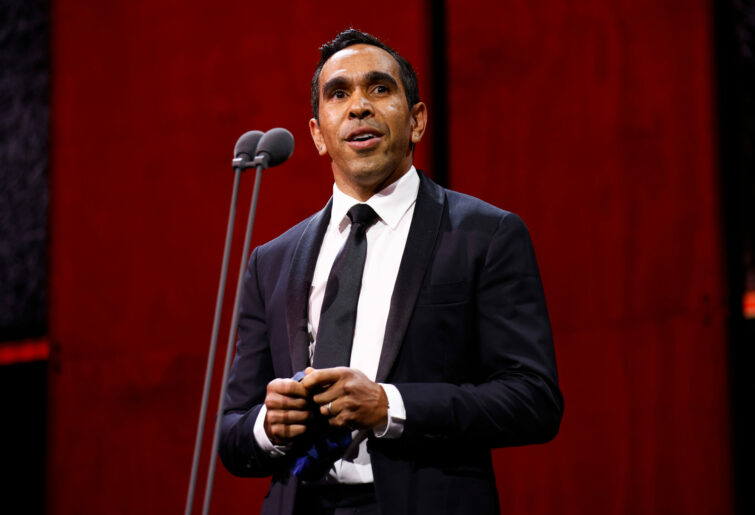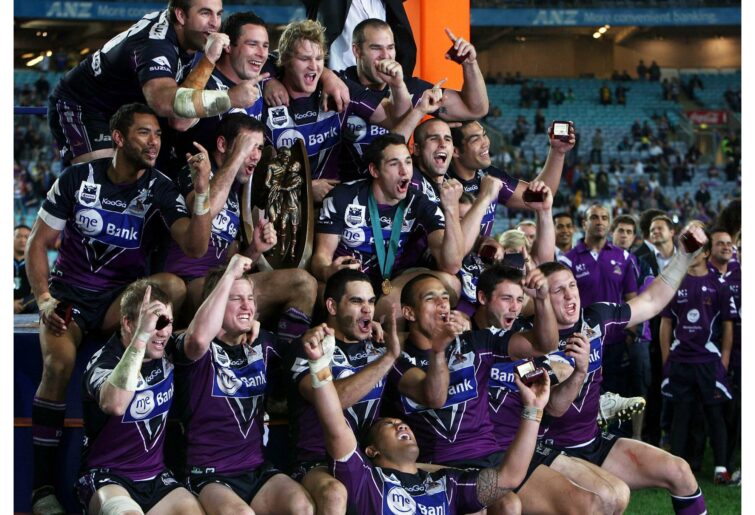In recent days, a few commentators have expressed an opinion that “only” soccer is the international game and can “unite Australia”.
The sentiment suggests that more Australians should be supporting the biggest world sport of all.
But, I for one, embrace Australia’s soccer history, the nation’s interest in many football codes, and Australia’s 2022 World Cup (WC) performance and all others over the years.
Soccer is indeed the world’s most competitive sport, and just making the World Cup competition is a considerable achievement, never mind winning a few matches and making the last 16 as the Socceroos did in 2022.

(Photo by Marvin Ibo Guengoer – GES Sportfoto/Getty Images)
I have faith that our youngsters (and us older fans) will continue to embrace different codes, although I recognise that competition between the sports can lead to changing fortunes for each code over time.
I celebrate our sporting diversity.
Mathew Leckie, one of Australia’s current soccer stars, used to play Australian rules football until the age 11 before playing soccer with his school mates at an inner west Melbourne school.
Leckie (an Essendon AFL supporter) notes how his family always got together to support Australia at the World Cup, and how he caught the soccer bug at 16 when watching the 2006 WC.
He states “How big the World Cup is could be just one of those things that clicks in their heads and says I want to be a footballer rather than an AFL player”.
Alex Jesaulenko, one of the all-time Australian rules greats, only started playing that sport when 14 years of age after earlier playing soccer and rugby union.
For those of us fans who are beyond single football code loyalty, all of the football codes are great games although we too will discuss elements of each game which we may consider imperfect.
While I am not here today to offer my opinion on the strengths and weaknesses of each code, albeit AFL still remains my favourite game, I watch every football code including American football, international rugby sevens and even Gaelic football when I can.
Of soccer, I have always been fascinated by its global popularity and history, along with enjoying the technical and tactical skills needed.
AFL, which I was brought up with, is so athletic and has pace and physicality which I very much enjoy.
The rugby codes interest me because they involve raw speed and power and I do admire their physical nature, although they have rightfully sought to make their games much safer and more attractive in recent years with some important rule changes.
No one really needs to undermine one game over another in terms of background detail either.
I do not think it is accurate to accuse any Australian football code of not being able to see beyond the colour of a player’s skin any more than another.
Like any multi-ethnic country, all of the Australian football codes experience dark days with regard to racism.
While Australian rules has had many adverse situations involving indigenous players, perhaps reflective of the reality that it (and rugby league) attracted most of their talented sportsmen over the years, no football codes has been immune from racism.
A quick search of Wikipedia highlights a number of recent incidents with soccer.
In 2000, it was reported that Perth Glory striker Bobby Despotovski called Melbourne Knights defender Ransford Banini a “black monkey”, although Despotovski denied this and claimed that he had said “shut up monkey”.
In 2008, South Korean-born Lee Corey, a referee, abandoned a South Australian State League fixture because of numerous racial taunts by spectators.
In 2012, an Adelaide United fan was banned for two years after racially abusing the Wellington Phoenix player Paul Ifill (English with Barbados ancestry) at Hindmarsh Stadium.
In 2014, Ali Abbas Al-Hilfi (Sydney FC) alleged that Western Sydney Wanderers FC striker Brendon Santalab racially vilified him during a match at Allianz Stadium, although a disciplinary committee dropped the charges when citing a lack of evidence and the possibility that Abbas may have misheard the comments made.
Most recently attention was given to a minority of Sydney United fans at the Australia Cup Final soccer match at Commbank Stadium in Sydney which drowned out the Welcome to Country, hailed Croatian Nazi salutes, and sung Croatian fascist Ustasha songs from World War II.
Given the Ustasha atrocities against Jews, Roma, Croatians, Serbians, Albanians and others, not to mention the disrespect shown towards indigenous Australians, you would be hard pressed to find a more horrible example of racism in recent times involving Australian sport.
In all likelihood, although it is always difficult to quantify social attitudes, most spectators today (any football) code would feel the same empathy for Indigenous AFL legends like Eddie Betts when they appear on television in tears after another incident reporting racism.

Eddie Betts (Photo by Daniel Pockett/Getty Images)
As for the hope that Australian soccer can become even bigger, building upon its high number of participants and national team interest, I also reject simplistic digs at the media.
A biased media of the past did not prevent soccer from becoming bigger from the 1950s, largely fuelled by European migration after the Second World War, nor has it prevented soccer from hosting some of the most viewed Australian sporting events in recent decades.
Many Australians, beyond those who once remained loyal to the game of their parents where soccer was most popular, now want to play the biggest international game.
As far as I know, there has never been any systematic push to keep soccer down, as was the case in France when the Vichy government of the Second World War organised the complete abolition of rugby league at a time when professional rugby league maintained a strong and vibrant club competition across large parts of France.
With the Vichy government stripping French rugby league’s considerable pre-war assets and its Sports Council giving it to rugby union, rugby league also suffered after World War Two through a government decree which proclaimed that rugby league could not be played in schools while professional rugby league was limited in terms of players and teams.
In contrast, Australians have been relatively free to support any sport they like, just as any organisation is free to promote their sport.
Especially today in this age where newspapers and free-to-air tv have diminished influence, I do not believe the destiny of any sport depends on a core group of businessmen or anyone else in terms of any desire to threaten the long-term survival of another game.

Sport in Australia is far less regional than it used to be (Photo by Mark Kolbe/Getty Images)
Although Australian soccer was the first sport to have a national league with clubs from different states, the rationalisation of product by the media corporations has helped expose more people in different states to quality matches in all codes.
Now all of the major cities want to host big AFL, soccer and rugby games.
It is not that the Australian television networks have not had a go with the A-League, albeit many do argue that they did not promote the product well enough.
The simple truth is that Australian fans will gravitate to the sport of their choice.
If media saturation was to explain a sport’s plight, then why has the immense corporate support of cricket not prevented the demise of crowds for recent Australian test and one day internationals.
It can be argued that the A-league is now the biggest summer sport in Australia in spectator terms with its many weekly matches having an average crowd this season above 9,000, although it remains to be seen whether cricket crowds return to the Big Bash League.
Whether one likes an outcome or not, the fans will speak with their feet.
Notwithstanding the most popular AFL and NRL club competitions, which averaged 32,600 and 16,600 per match in 2022, big Australians crowds continue to go to soccer matches and rugby union internationals.
I have no doubt that World Cup matches in 2023 for the women will generate excellent Australian crowds, especially for the Matildas.
I have always believed that the more professional sports there are, the better for the economy, the better for spectators, and a better opportunity for young sportspeople to make a living.
That, for me, defines a true sporting nation and makes Australia one of the best sporting countries in the world.
For those passionate soccer fans, those who are competitive in their views and desire to grow the game, there has to be a better way to promote the sport beyond stating it is the biggest in the world and the only sport capable of uniting Australians.
Soccer has a number of strengths.
It is safer than other codes. It is one of the reasons why I prefer watching the Matildas to any AFLW match.
It is fun game. I remember my serious weight training days when most of us (around 100kg or heavier) would meet at Reservoir’s Edwards Park on a Sunday afternoon for a soccer game.
As far as I recall, most of us loved AFL too.
As a sport that occurs in the Spring and Summer at the highest club level, it offers one of the few professional club competitions to attend during these warmer months, although I recognise that it is a Winter sport.
Nevertheless, the same planning tactic is helping US soccer boom, so perhaps more night games are needed to avoid the burning sun during the day in these warmer months.

Caitlin Foord of the Matildas (Photo by Robert Cianflone/Getty Images)
Soccer also provides many global opportunities for young Australian players to make a decent living, perhaps much more so than via the AFL and rugby codes.
As we know, money can talk in terms of our talented youth making their dedicated sporting decisions after playing a variety of sports.
And it is the international game played extensively by most countries, a game where physical prowess and sheer numbers alone can never determine a result, thus meaning that skill and teamwork can go a long way in terms of generating success with the right culture.
Poor old China, with all of its vast resources and efforts to dominate global sports, appears to still be light years away from being a soccer superpower.
I think such points should be the selling point for soccer rather than any controversial points being made against other football codes.
































































































